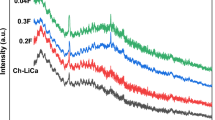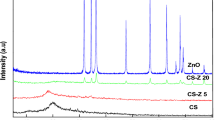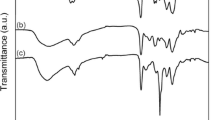Abstract
Properties such as absorption, structural and external aspect of Carbopol/silver nanoparticles composites, prepared in DMF by heating process up to 30, 60, 80, 100 and 120 °C, were investigated by UV-visible, FTIR and SEM-EDS analyses. Samples were named respectively D30 to D120, according to the temperature at which they were extracted. The results showed that instead of the appearance of silver aggregates observed by SEM microscopy, all the obtained materials present a single absorption band centred at 430 nm, attributed to the classical surface plasmon excitation of the silver nanoparticles. The presence of silver nanoparticles is also proved by the X-ray powder diffraction XRD patterns, which show the appearance of small peaks corresponding to the face centered cubic (f.c.c.) silver phase in the case of D100 and D120 samples. Additionally strong interactions between silver ions and carboxylic groups of Carbopol were identified by ATR-FTIR spectroscopy. The thermal properties of the carbopol are effectively enhanced by the presence of silver nanoparticles as evidenced by thermo-gravimetric analysis. Furthermore the water loss that generally occurs at 100 °C in acrylic acid polymer was completely avoided in these new materials since less than 2 % of weight loss is recorded up to 160 °C. Finally, the inhibiting activity of Carbopol/silver nanoparticles composites against staphylococcus Aureus micro-organisms was confirmed for all the obtained materials, suggesting their suitable uses as effective growth inhibitors of micro-organisms and making them appropriate for diverse antimicrobial control systems.








Similar content being viewed by others
References
Chen TK, Tien YI (2000) Polymer 41:1345
Eid M., El-Arnaouty M. B., El-Sayed MS, Hegazy A. (2012) J Polym Res 19:9835
Youyi S, Yaqing L, Zhao G, Qijin Z (2008) J Polym Res 15:269–273
Lin JC, Yang CY (1996) Mater Chem Phys 45:136
Xinming W, Shuhua Q, Guochen D (2010) J Polym Res 17:751–757
Fen QL, Cui FZ, Kin TN, Kin JW (1999) Mater Sci Lett 18:559
Montazer M, Malekzadeh SB (2012) J Polym Res 19:9980
Fritzsche W, Porwol H, Wiegand A, Bornman S, Köhler JM (1998) Nano Mater 10:89
Naom H, Farooqi ZH, Shah LA, Siddiq M (2012) J Polym Res 19:9950
Xu GC, Shi JJ, Li DJ, Xing HL (2009) J Polym Res 16:295–299
Li Y, Wu Y, Ong BS (2005) J Am Chem Soc 127:3266
Wissawin K, Anuvat S (2014) J Polym Res 21:369
Dong J, Ozaki Y, Nakashima K (1997) Macromolecules 30:1111
Dong J, Ozaki Y (1997) Macromolecules 30:286
Kabin K, Lashani S, Zohuriaan-Mehr MJ, Kheirabadi M (2011) J Polym Res 18:449
Cruickshank R, Duguid JP, Marion BP, Swain RHA (1975) Medicinal Microbiology, 12th ed, vol II. Churchill Livingstone, London, 196
Henglein A, Mulvaney P, Linnert T (1991) Faraday discussion 92:31–44
McClune WF (1993) Powder Diffraction File-Inorganic and Organic. Joint Committee on Powder Diffraction Standards of the International Center for Diffraction Data in cooperation with the American Ceramic Society, Swarthmore, PA
Chalal S, Haddadine N, Bouslah N, Benaboura A (2012) J Polym Res 19:24
Dong J, Ozaki Y, Nakashima K (1997) Macromolecules 30:1111
Dong J., Ozaki Y. Macromolecules 1997;30: 286
Haddadine N, Amrani F, Arrighi V, Cowie JMG (2008) Eur Polym J 44:821–831
Haddadine N, Amrani F, Arrighi V, Cowie JM (2008) Therm chim Acta 475:25–32
Morones JR, Elechiguerra JL, Camacho A, Holt K, Kouri JB, Ramírez JP, Yacaman MJ (2005) Nanotechnology 16:2346
Author information
Authors and Affiliations
Corresponding authors
Rights and permissions
About this article
Cite this article
Haddadine, N., Chalal, S., Bouslah, N. et al. Preparation and characterization of carbopol/silver nanoparticles composites obtained by heating process for antimicrobial application. J Polym Res 21, 477 (2014). https://doi.org/10.1007/s10965-014-0477-5
Received:
Accepted:
Published:
DOI: https://doi.org/10.1007/s10965-014-0477-5




